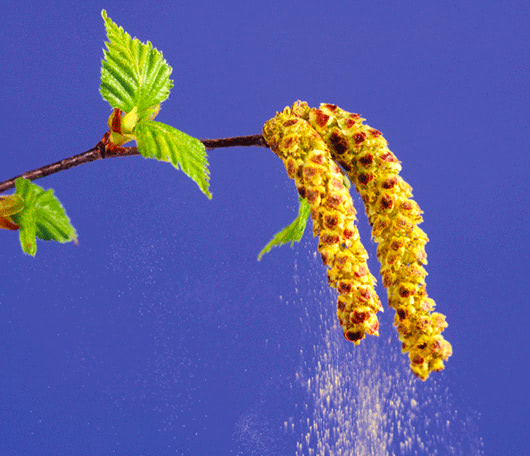We recreate the landscape according to our image of nature and to match our needs and expectations. This also applies for the urban landscape. In the NY Times of last week, Thomas Leo Ogren pleas for Allergy-Free Gardening in New York City, to improve the quality of life in the Big Apple. It seems there is a big market for hypo-allegenic urban tree species…
BY THOMAS LEO OGREN – As certain trees burst into bloom in spring, their pollen wafts through the air in a wanton attempt to reach receptive blossoms. Millions of people with allergies pay the price, in sneezing, wheezing, coughing, drowsiness and itchy, watery eyes. They needn’t suffer so much. Cities could reduce the misery by planting street trees that produce very little pollen or none at all.
Street trees weren’t always as allergenic as they are today. Back in the 1950s, the most popular species planted in the United States was the native American elm, which sheds little pollen. Millions of these tall, stately trees lined the streets of towns and cities from coast to coast. Sadly, in the 1960s and ’70s, Dutch elm disease killed most of the elms, and many of them were replaced with species that are highly allergenic.
This has caused trouble for Americans with allergies — as many as 30 percent of adults and 40 percent of children — most of whom are sensitive to pollen, as well as for the many millions who have allergy-induced asthma. Although some pollen can be carried great distances by the wind, most atmospheric pollen comes from plants growing nearby. In other words, the pollen that’s making you sneeze as you walk down the street probably came from the tree you just passed. So it makes sense for gardeners, especially public gardeners who plant trees by the dozens, to pay attention to the pollen their trees produce.
Some trees shed huge amounts of highly allergenic pollen; others produce very little, or their pollen is only moderately irritating. Female plants produce no pollen at all. But arborists rarely take this into account. In New York City, street trees are selected only for their hardiness in winter; their resistance to disease, insects and drought; their ability to withstand smog; and their size, shape and color.
The pollen that causes the most severe allergic reactions comes from a few so-called monoecious species of trees, which have both male and female flowers, and from the males of separate-sexed (dioecious) species. Many arborists and landscapers like to plant male trees and shrubs because they’re “litter-free” — that is, they produce no seeds or seedpods. But male trees shed lots of pollen; that’s their job. And once it’s released, it can be blown around for months.
In New York City, about 30 percent of the street trees are Norway maples and London planes, both monoecious kinds that always produce allergenic pollen. And of the total 5.2 million trees growing on the city’s private and public lands, some 300,000 are male mulberry trees and almost 100,000 are box elders, mostly also male — making it all the more important to reduce the number of allergenic trees along the streets.
Another problem with New York City street trees is that there are so few kinds of them. Only 10 species of trees account for nearly three-fourths of the total. That means New Yorkers are repeatedly exposed to the same kinds of pollen, which increases the likelihood that they will develop allergies. City arborists could set a healthy example for property owners by increasing the diversity of street tree species and choosing low-pollen kinds.
They should consider planting and encouraging people to plant many more tulip poplar, hawthorn, goldenrain, dawn redwood, mountain ash, apple and serviceberry. And they could make far greater use of female trees of many varieties, including junipers, yews, aspens, cottonwoods, poplars, Chinese pistaches, red maples, silver maples, box elders, tupelos, willows and sassafras.
Of course, it would not be possible, or even desirable, to landscape in such a way as to eliminate all pollen. The aim should be to reduce people’s total exposure. Lowering the dose reduces allergy symptoms in some people, and in others it eliminates suffering altogether.
Nor would we ever want to replace all street trees that are young and in good health. But trees are continually being replaced. Each year, ice storms, destructive beetles, disease, vandalism and old age kill huge numbers of them. Every one of these should be replaced with a low-allergy tree. Only in the case of the most allergenic trees — male box elder, yew and mulberry — should city arborists consider deliberate removal.
Those extraordinarily allergenic mulberry trees could be made less irritating to allergy sufferers if they were given a sex change — that is, top-grafted with weeping mulberry, which is female and pollen-free.
It’s been three decades since Walter H. Lewis, America’s foremost pollen expert, wrote, “It makes no sense to plant highly allergenic trees or shrubs close to where we live.” Yet city gardeners still do so every day. Why not instead plant the kind with less pollen — and make it much easier for everyone to enjoy the beauty and the shade?
By Thomas Leo Ogren, author of “Allergy-Free Gardening: The Revolutionary Guide to Healthy Landscaping.” This article was originally published on april 5th 2010 by the NY times. Illustration by Karen Barbour.

Share your thoughts and join the technology debate!
Be the first to comment